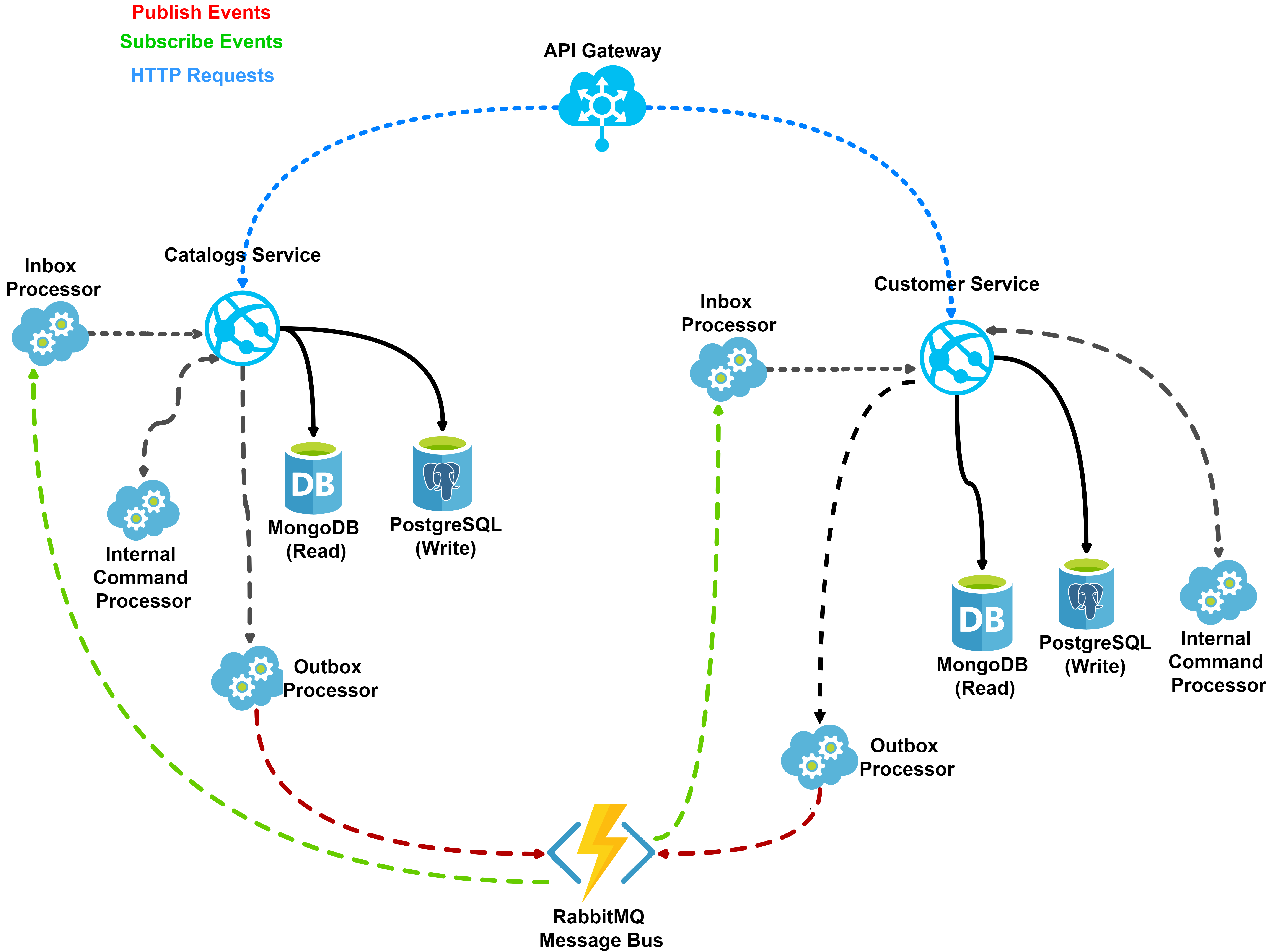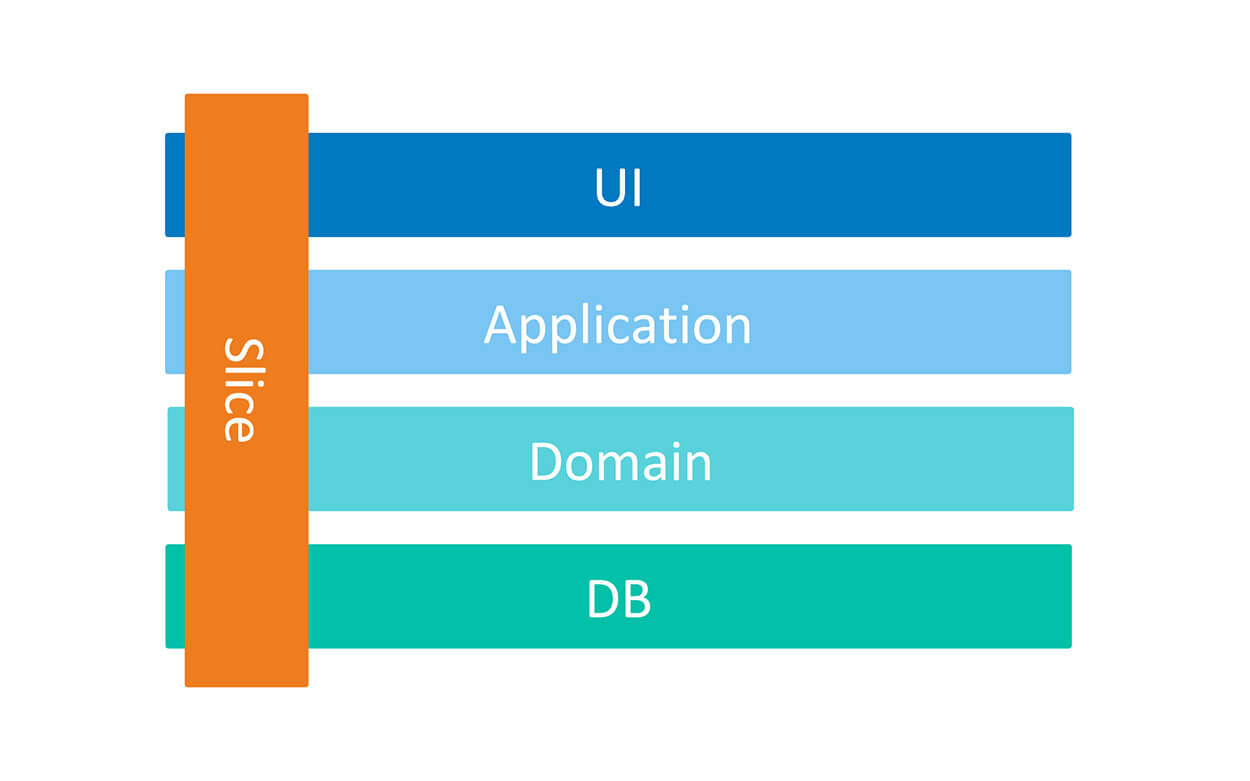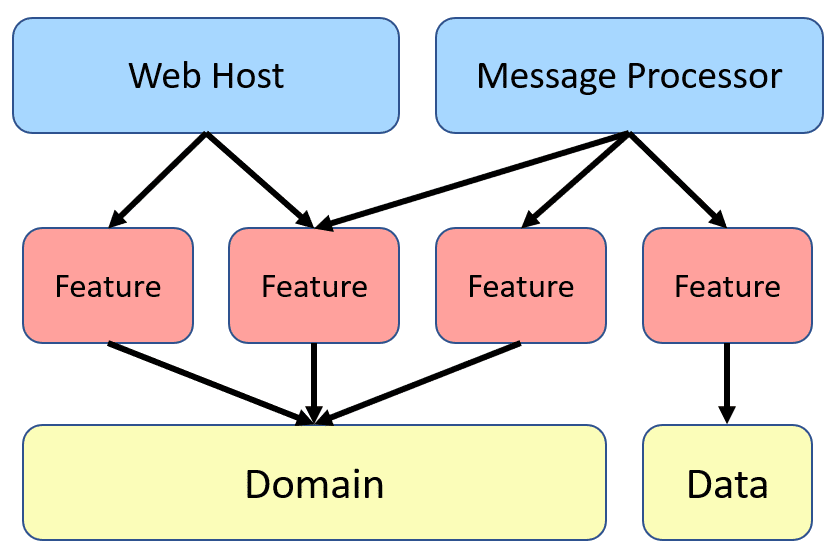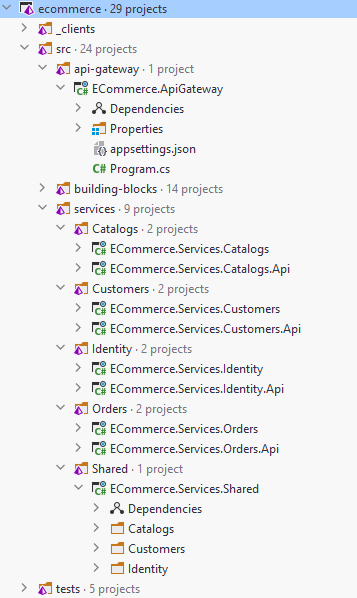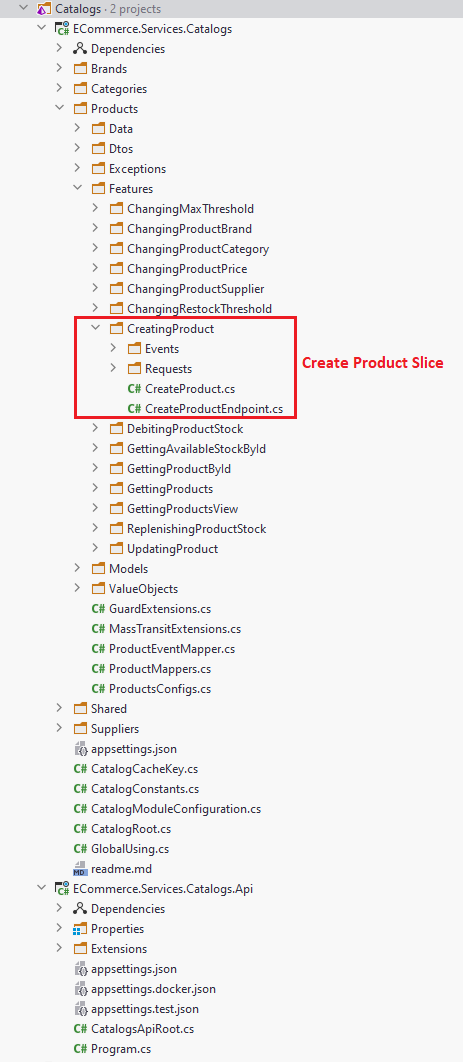ECommerece Microservicesis a fictional ecommerce sample, built with .Net Core and different software architecture and technologies like Microservices Architecture, Vertical Slice Architecture , CQRS Pattern, Domain Driven Design (DDD), Event Driven Architecture. For communication between independent services, we use asynchronous messaging with using rabbitmq on top of MassTransit library, and sometimes we use synchronous communication for real-time communications with using REST and gRPC calls.
💡 This application is not business oriented and my focus is mostly on technical part, I just want to implement a sample with using different technologies, software architecture design, principles and all the thing we need for creating a microservices app.
Warning This project is in progress. I add new features over the time. You can check the Release Notes and follow the progress on Twitter @mehdi_hedli and Linkedin mehdihadeli.
🎯 This Application ported to modular monolith approach in ecommerce-modular-monolith repository, we can choose best fit architecture for our projects based on production needs.
Other versions of this project are available in these repositories, We can choose best fit architecture for our projects based on production needs:
- https://github.com/mehdihadeli/ecommerce-modular-monolith
- https://github.com/mehdihadeli/go-ecommerce-microservices
For your simplest .net core projects, you can use my vertical-slice-api-template project template:
If you like feel free to ⭐ this repository, It helps out :)
Thanks a bunch for supporting me!
- Features
- Plan
- Setup
- Technologies - Libraries
- The Domain and Bounded Context - Service Boundary
- Application Architecture
- Application Structure
- Vertical Slice Flow
- Prerequisites
- How to Run
- Contribution
- Project References
- License
- ✅ Using
MicroservicesandVertical Slice Architectureas a high level architecture - ✅ Using
Event Driven Architectureon top of RabbitMQ Message Broker and MassTransit library - ✅ Using
Domain Driven Designin most of services like Customers, Catalogs, ... - ✅ Using
Event SourcingandEventStoreDBinAudit Basedservices like Orders, Payment - ✅ Using
Data Centeric Architecturebased onCRUDin Identity Service - ✅ Using
CQRS Patternon top ofMediatRlibrary and splitingread modelsandwrite models - ✅ Uing
Structured loggingwith serilog and exporting logs toElastic SeacrchandKibanathrough serilog-sinks-elasticsearch sink - ✅ Using
Outbox Patternfor all microservices for Guaranteed Delivery or At-least-once Delivery - ✅ Using
Inbox Patternfor handling Idempotency in reciver side and Exactly-once Delivery - ✅ Using
UnitTestsandNSubstitutefor mocking dependencies - ✅ Using
Integration TestsandEnd To End Testson top of testcontainers-dotnet library for cleanup our test enviroment through docker containers - ✅ Using
Minimal APIsfor handling requests - ✅ Using
Fluent Validationand a Validation Pipeline Behaviour on top of MediatR - ✅ Using
Postgresfor write database as relational DB andMongoDBandElasric Searchfor read database - ✅ Using docker and
docker-composefor deployment - ✅ Using Microsoft Tye for deployment
- ✅ Using YARP reverse proxy as API Gateway
- ✅ Using different type of tests like
Unit Tests,Integration Tests,End-To-End Testsand testcontainers for testing in isolation - 🚧 Using
Helm,KubernetesandKustomizefor deployment - 🚧 Using
OpenTelemetryfor collectingMetricsandDistributed Traces
This project is in progress, New features will be added over time.
- ✔️
.NET 7- .NET Framework and .NET Core, including ASP.NET and ASP.NET Core - ✔️
MassTransit- Distributed Application Framework for .NET - ✔️
StackExchange.Redis- General purpose redis client - ✔️
Npgsql Entity Framework Core Provider- Npgsql has an Entity Framework (EF) Core provider. It behaves like other EF Core providers (e.g. SQL Server), so the general EF Core docs apply here as well - ✔️
EventStore-Client-Dotnet- Dotnet Client SDK for the Event Store gRPC Client API written in C# - ✔️
FluentValidation- Popular .NET validation library for building strongly-typed validation rules - ✔️
Swagger & Swagger UI- Swagger tools for documenting API's built on ASP.NET Core - ✔️
Serilog- Simple .NET logging with fully-structured events - ✔️
Polly- Polly is a .NET resilience and transient-fault-handling library that allows developers to express policies such as Retry, Circuit Breaker, Timeout, Bulkhead Isolation, and Fallback in a fluent and thread-safe manner - ✔️
Scrutor- Assembly scanning and decoration extensions for Microsoft.Extensions.DependencyInjection - ✔️
Opentelemetry-dotnet- The OpenTelemetry .NET Client - ✔️
DuendeSoftware IdentityServer- The most flexible and standards-compliant OpenID Connect and OAuth 2.x framework for ASP.NET Core - ✔️
Newtonsoft.Json- Json.NET is a popular high-performance JSON framework for .NET - ✔️
Rabbitmq-dotnet-client- RabbitMQ .NET client for .NET Standard 2.0+ and .NET 4.6.1+ - ✔️
AspNetCore.Diagnostics.HealthChecks- Enterprise HealthChecks for ASP.NET Core Diagnostics Package - ✔️
Microsoft.AspNetCore.Authentication.JwtBearer- Handling Jwt Authentication and authorization in .Net Core - ✔️
NSubstitute- A friendly substitute for .NET mocking libraries. - ✔️
StyleCopAnalyzers- An implementation of StyleCop rules using the .NET Compiler Platform - ✔️
AutoMapper- Convention-based object-object mapper in .NET. - ✔️
Hellang.Middleware.ProblemDetails- A middleware for handling exception in .Net Core - ✔️
IdGen- Twitter Snowflake-alike ID generator for .Net
This application uses Https for hosting apis, to setup a valid certificate on your machine, you can create a Self-Signed Certificate, see more about enforce certificate here and here.
- Setup on windows and
powershell:
dotnet dev-certs https --clean
dotnet dev-certs https -ep $env:USERPROFILE\.aspnet\https\aspnetapp.pfx -p <CREDENTIAL_PLACEHOLDER>
dotnet dev-certs https --trust- Setup in
linux and wsl:
dotnet dev-certs https --clean
dotnet dev-certs https -ep ${HOME}/.aspnet/https/aspnetapp.pfx -p <CREDENTIAL_PLACEHOLDER>
dotnet dev-certs https --trustdotnet dev-certs https --trust is only supported on macOS and Windows. You need to trust certs on Linux in the way that is supported by your distribution. It is likely that you need to trust the certificate in your browser(with this certificate we don't get an exception for https port because of not found certificate but browser shows us this certificate is not trusted).
In this app I use Conventional Commit and for enforcing its rule I use conventional-changelog/commitlint and typicode/husky with a pre-commit hook. For read more about its setup see commitlint docs and this article and this article.
Here I configured a husky hook for conventional commits:
- Install NPM:
npm init- Install Husky:
npm install husky --save-dev- Add
prepareandinstall-dev-cert-bashcommand for installing and activatinghusky hooksin the package.json file:
npm pkg set scripts.prepare="husky install && dotnet tool restore"
npm pkg set scripts.install-dev-cert-bash="curl -sSL https://aka.ms/getvsdbgsh | bash /dev/stdin -v vs2019 -l ~/vsdbg"- Install CommitLint:
npm install --save-dev @commitlint/config-conventional @commitlint/cli- Create the
commitlint.config.jsfile with this content:
module.exports = { extends: '@commitlint/config-conventional']};- Create the Husky folder:
mkdir .husky- Link Husky and CommitLint:
npx husky add .husky/commit-msg 'npx --no -- commitlint --edit ${1}'- Activate and installing all husky hooks with this command:
npm run prepare
# this command should run in git-bash on the windows or bash in the linux
npm run install-dev-cert-bashFor formatting I use belav/csharpier but you can also use dotnet format, you can integrate it with your prefered IDE.
Here I configured a husky hook for formatting:
- Install NPM:
npm init- Install Husky:
npm install husky --save-dev- Install Husky:
npm install husky --save-dev- Install manifest file with
dotnet new tool-manifestbecause it doesn't exist at first time and then install our required packages as dependency with dotnet tool install, that will add to dotnet-tools.json file in a.configdirectory:
dotnet new tool-manifest
dotnet tool install csharpier
dotnet tool install dotnet-format- Add
preparecommand for installing and activatinghusky hooksandrestoringour installed dotnet tools in the previous step to the package.json file:
npm pkg set scripts.prepare="husky install && dotnet tool restore"- Create the Husky folder:
mkdir .husky- Link Husky and formatting tools:
npx husky add .husky/pre-commit "dotnet format"
# Or using csharpier
npx husky add .husky/pre-commit "dotnet csharpier ."- Activate and installing all husky hooks with this command:
npm run prepareFor roslyn analizers I use serveral analyzers and config the in .editorconfig file:
- StyleCop/StyleCop
- JosefPihrt/Roslynator
- meziantou/Meziantou.Analyzer
- Microsoft.VisualStudio.Threading.Analyzers
ECommerce Microservices is a simple online ecommerce api sample that has the basic business scenario for online purchasing with some dedicated services. There are six possible Bounded context or Service for above business:
-
Identity Service: the Identity Service uses to authenticate and authorize users through a token. Also, this service is responsible for creating users and their corresponding roles and permission with using .Net Core Identity and Jwt authentication and authorization. I will add also Identity Server in future for this service. Each ofAdministrator,CustomerandSupplierare aUser, actually aIdentityUser. To be a User, User Registration is required. Each User is assigned one or more User Role. Each User Role has set of Permissions. A Permission defines whether User can invoke a particular action or not. -
Catalog Service: The Catalog Service presents the ability to add items to our ecommerce, It can be electronics, foods, books or anything else. Items can be grouped into categories and catalogs. A catalog is defined as a list of items that a company showcases online. the catalog is a collection of items, which can be grouped into categories. An item can be assigned to only one category or be direct child of a catalog without any category. Buyer can browse the products list with supported filtering and sorting by product name and price. customer can see the detail of the product on the product list and in the detail page, can see a name, description, available product in the inventory,... -
Customers Service: This service is responsible for managing our customers information, track the activities and subscribing to get notification for out of stock products -
Order Service: The Orders Service main purpose is to ecommerce order details and manage orders created by users on client side. This service is not designed to be a full order processing system like ERP but serves as storage for customer orders details and can be synchronized with different external processing systems. Some of this service responsibilities areSaving orders,Saving order drafts,Ability to view and manage fulfillment, packages,Change discounts -
Payment Service: The payment service is responsible for payment process of our customer with different payment process and managing and tracking our payment history -
Shipping Service: The Shipping Service provides the ability to extend shipping provider list with custom providers and also provides an interface and API for managing these shipping providers. Some of shipping service capabilities areRegister Shipping methods,Edit Shipping method,Shipment details,Shipping settings
The bellow architecture shows that there is one public API (API Gateway) which is accessible for the clients and this is done via HTTP request/response. The API gateway then routes the HTTP request to the corresponding microservice. The HTTP request is received by the microservice that hosts its own REST API. Each microservice is running within its own AppDomain and has directly access to its own dependencies such as databases, files, local transaction, etc. All these dependencies are only accessible for that microservice and not to the outside world. In fact microservices are decoupled from each other and are autonomous. This also means that the microservice does not rely on other parts in the system and can run independently of other services.
Microservices are event based which means they can publish and/or subscribe to any events occurring in the setup. By using this approach for communicating between services, each microservice does not need to know about the other services or handle errors occurred in other microservices.
In this architecture we use CQRS Pattern for separating read and write model beside of other CQRS Advantages. Here for now I don't use Event Sourcing for simplicity but I will use it in future for syncing read and write side with sending streams and using Projection Feature for some subscribers to syncing their data through sent streams and creating our Custom Read Models in subscribers side.
Here I have a write model that uses a postgres database for handling better Consistency and ACID Transaction guaranty. beside o this write side I use a read side model that uses MongoDB for better performance of our read side without any joins with suing some nested document in our document also better scalability with some good scaling features of MongoDB.
For syncing our read side and write side we have 2 options with using Event Driven Architecture (without using events streams in event sourcing):
-
If our
Read Sidesare inSame Service, during saving data in write side I save a Internal Command record in myCommand Processorstorage (like something we do in outbox pattern) and after commiting write side, ourcommand processor managerreads unsent commands and sends them to theirCommand Handlersin same corresponding service and this handlers could save their read models in our MongoDb database as a read side. -
If our
Read Sidesare inAnother Serviceswe publish an integration event (with saving this message in the outbox) after committing our write side and all of ourSubscriberscould get this event and save it in their read models (MongoDB).
All of this is optional in the application and it is possible to only use what that the service needs. Eg. if the service does not want to Use DDD because of business is very simple and it is mostly CRUD we can use Data Centric Architecture or If our application is not Task based instead of CQRS and separating read side and write side again we can just use a simple CRUD based application.
Here I used Outbox for Guaranteed Delivery and can be used as a landing zone for integration events before they are published to the message broker .
Outbox pattern ensures that a message was sent (e.g. to a queue) successfully at least once. With this pattern, instead of directly publishing a message to the queue, we ecommerce it in the temporary storage (e.g. database table) for preventing missing any message and some retry mechanism in any failure (At-least-once Delivery). For example When we save data as part of one transaction in our service, we also save messages (Integration Events) that we later want to process in another microservices as part of the same transaction. The list of messages to be processed is called a StoreMessage with Message Delivery Type Outbox that are part of our MessagePersistence service. This infrastructure also supports Inbox Message Delivery Type and Internal Message Delivery Type (Internal Processing).
Also we have a background service MessagePersistenceBackgroundService that periodically checks the our StoreMessages in the database and try to send the messages to the broker with using our MessagePersistenceService service. After it gets confirmation of publishing (e.g. ACK from the broker) it marks the message as processed to avoid resending.
However, it is possible that we will not be able to mark the message as processed due to communication error, for example broker is unavailable. In this case our MessagePersistenceBackgroundService try to resend the messages that not processed and it is actually At-Least-Once delivery. We can be sure that message will be sent once, but can be sent multiple times too! That’s why another name for this approach is Once-Or-More delivery. We should remember this and try to design receivers of our messages as Idempotents, which means:
In Messaging this concepts translates into a message that has the same effect whether it is received once or multiple times. This means that a message can safely be resent without causing any problems even if the receiver receives duplicates of the same message.
For handling Idempotency and Exactly-once Delivery in receiver side, we could use Inbox Pattern.
This pattern is similar to Outbox Pattern. It’s used to handle incoming messages (e.g. from a queue) for unique processing of a single message only once (even with executing multiple time). Accordingly, we have a table in which we’re storing incoming messages. Contrary to outbox pattern, we first save the messages in the database, then we’re returning ACK to queue. If save succeeded, but we didn’t return ACK to queue, then delivery will be retried. That’s why we have at-least-once delivery again. After that, an inbox background process runs and will process the inbox messages that not processed yet. also we can prevent executing a message with specific MessgaeIdmultiple times. after executing our inbox message for example with calling our subscribed event handlers we send a ACK to the queue when they succeeded. (Inbox part of the system is in progress, I will cover this part soon as possible)
Also here I used RabbitMQ as my Message Broker for my async communication between the microservices with using eventually consistency mechanism, for now I used MassTransit tools for doing broker communications. beside of this eventually consistency we have a synchronous call with using REST (in future I will use gRpc) for our immediate consistency needs.
We use a Api Gateway and here I used YARP that is microsoft reverse proxy (we could use envoy, traefik, Ocelot, ...), in front of our services, we could also have multiple Api Gateway for reaching BFF pattern. for example one Gateway for mobile apps, One Gateway for web apps and etc.
With using api Gateway our internal microservices are transparent and user can not access them directly and all requests will serve through this Gateway.
Also we could use gateway for load balancing, authentication and authorization, caching ,...
In this project I used vertical slice architecture or Restructuring to a Vertical Slice Architecture also I used feature folder structure in this project.
- We treat each request as a distinct use case or slice, encapsulating and grouping all concerns from front-end to back.
- When We adding or changing a feature in an application in n-tire architecture, we are typically touching many different "layers" in an application. we are changing the user interface, adding fields to models, modifying validation, and so on. Instead of coupling across a layer, we couple vertically along a slice and each change affects only one slice.
- We
Minimize couplingbetween slices, andmaximize couplingin a slice. - With this approach, each of our vertical slices can decide for itself how to best fulfill the request. New features only add code, we're not changing shared code and worrying about side effects. For implementing vertical slice architecture using cqrs pattern is a good match.
Also here I used CQRS for decompose my features to very small parts that makes our application:
- maximize performance, scalability and simplicity.
- adding new feature to this mechanism is very easy without any breaking change in other part of our codes. New features only add code, we're not changing shared code and worrying about side effects.
- easy to maintain and any changes only affect on one command or query (or a slice) and avoid any breaking changes on other parts
- it gives us better separation of concerns and cross cutting concern (with help of MediatR behavior pipelines) in our code instead of a big service class for doing a lot of things.
With using CQRS, our code will be more aligned with SOLID principles, especially with:
- Single Responsibility rule - because logic responsible for a given operation is enclosed in its own type.
- Open-Closed rule - because to add new operation you don’t need to edit any of the existing types, instead you need to add a new file with a new type representing that operation.
Here instead of some Technical Splitting for example a folder or layer for our services, controllers and data models which increase dependencies between our technical splitting and also jump between layers or folders, We cut each business functionality into some vertical slices, and inner each of these slices we have Technical Folders Structure specific to that feature (command, handlers, infrastructure, repository, controllers, data models, ...).
Usually, when we work on a given functionality we need some technical things for example:
- API endpoint (Controller)
- Request Input (Dto)
- Request Output (Dto)
- Some class to handle Request, For example Command and Command Handler or Query and Query Handler
- Data Model
Now we could all of these things beside each other and it decrease jumping and dependencies between some layers or folders.
Keeping such a split works great with CQRS. It segregates our operations and slices the application code vertically instead of horizontally. In Our CQRS pattern each command/query handler is a separate slice. This is where you can reduce coupling between layers. Each handler can be a separated code unit, even copy/pasted. Thanks to that, we can tune down the specific method to not follow general conventions (e.g. use custom SQL query or even different storage). In a traditional layered architecture, when we change the core generic mechanism in one layer, it can impact all methods.
For implementing vertical slice architecture in each microservice, I have two projects, for example in Catalog Service I have ECommerce.Services.Catalogs project and ECommerce.Services.Catalogs.Api project.
ECommerce.Services.Catalogs.Apiis responsible for Hosting microservice and configuring ourweb api, running the application on top of .net core and actually serving our microservices slices to outside of world.ECommerce.Services.Catalogsis responsible for putting all slices (features) based on our functionality in some slices, for example we put all Features or Slices related toproductfunctionalities in Products folder, also we have a Shared Folder that contains some infrastructure things will share between all slices (for example Data-Context, ServiceCollectionExtensions.Persistence).
In vertical slice flow, we treat each request as a slice. For example for CreatingProduct feature or slice, Our flow will start with a Endpoint with name CreateProductEndpoint and inner this endpoint we handle the http request from out side of world and pass our request data with a mediator gateway to corresponding handler.
// POST api/v1/catalog/products
public static class CreateProductEndpoint
{
internal static IEndpointRouteBuilder MapCreateProductsEndpoint(this IEndpointRouteBuilder endpoints)
{
endpoints.MapPost($"{ProductsConfigs.ProductsPrefixUri}", CreateProducts)
.WithTags(ProductsConfigs.Tag)
.RequireAuthorization()
.Produces<CreateProductResult>(StatusCodes.Status201Created)
.Produces(StatusCodes.Status401Unauthorized)
.Produces(StatusCodes.Status400BadRequest)
.WithName("CreateProduct")
.WithDisplayName("Create a new product.");
return endpoints;
}
private static async Task<IResult> CreateProducts(
CreateProductRequest request,
ICommandProcessor commandProcessor,
IMapper mapper,
CancellationToken cancellationToken)
{
Guard.Against.Null(request, nameof(request));
var command = mapper.Map<CreateProduct>(request);
var result = await commandProcessor.SendAsync(command, cancellationToken);
return Results.CreatedAtRoute("GetProductById", new { id = result.Product.Id }, result);
}
}In this endpoint we use CQRS and pass CreateProduct command to our command processor for executing and route to corresponding CreateProductHandler command handler.
public record CreateProduct(
string Name,
decimal Price,
int Stock,
int RestockThreshold,
int MaxStockThreshold,
ProductStatus Status,
int Width,
int Height,
int Depth,
string Size,
ProductColor Color,
long CategoryId,
long SupplierId,
long BrandId,
string? Description = null,
IEnumerable<CreateProductImageRequest>? Images = null) : ITxCreateCommand<CreateProductResult>
{
public long Id { get; init; } = SnowFlakIdGenerator.NewId();
}
public class CreateProductHandler : ICommandHandler<CreateProduct, CreateProductResult>
{
private readonly ILogger<CreateProductHandler> _logger;
private readonly IMapper _mapper;
private readonly ICatalogDbContext _catalogDbContext;
public CreateProductHandler(
ICatalogDbContext catalogDbContext,
IMapper mapper,
ILogger<CreateProductHandler> logger)
{
_logger = Guard.Against.Null(logger, nameof(logger));
_mapper = Guard.Against.Null(mapper, nameof(mapper));
_catalogDbContext = Guard.Against.Null(catalogDbContext, nameof(catalogDbContext));
}
public async Task<CreateProductResult> Handle(
CreateProduct command,
CancellationToken cancellationToken)
{
Guard.Against.Null(command, nameof(command));
var images = command.Images?.Select(x =>
new ProductImage(SnowFlakIdGenerator.NewId(), x.ImageUrl, x.IsMain, command.Id)).ToList();
var category = await _catalogDbContext.FindCategoryAsync(command.CategoryId);
Guard.Against.NotFound(category, new CategoryDomainException(command.CategoryId));
var brand = await _catalogDbContext.FindBrandAsync(command.BrandId);
Guard.Against.NotFound(brand, new BrandNotFoundException(command.BrandId));
var supplier = await _catalogDbContext.FindSupplierByIdAsync(command.SupplierId);
Guard.Against.NotFound(supplier, new SupplierNotFoundException(command.SupplierId));
var product = Product.Create(
command.Id,
command.Name,
Stock.Create(command.Stock, command.RestockThreshold, command.MaxStockThreshold),
command.Status,
Dimensions.Create(command.Width, command.Height, command.Depth),
command.Size,
command.Color,
command.Description,
command.Price,
category!.Id,
supplier!.Id,
brand!.Id,
images);
await _catalogDbContext.Products.AddAsync(product, cancellationToken: cancellationToken);
await _catalogDbContext.SaveChangesAsync(cancellationToken);
var created = await _catalogDbContext.Products
.Include(x => x.Brand)
.Include(x => x.Category)
.Include(x => x.Supplier)
.SingleOrDefaultAsync(x => x.Id == product.Id, cancellationToken: cancellationToken);
var productDto = _mapper.Map<ProductDto>(created);
_logger.LogInformation("Product a with ID: '{ProductId} created.'", command.Id);
return new CreateProductResult(productDto);
}
}This command handler will execute in a transaction with using EfTxBehavior pipeline, because CreateProduct inherits from ITxCreateCommand.
And in the end of this handler before Committing Transaction we publish our domain events to their handlers with help of DomainEventPublisher. Also after publishing our domain event handlers, if We have a valid EventMapper for mapping our domain events to integration events we can get their corresponding Integration Events for example ProductEventMapper is a event mapping file for products functionality.
These integration events will Save in the persistence message store, with help of MessagePersistenceService as StoreMessage with MessageDeliveryType Outbox for guaranty delivery before committing.
After Committing Transaction our MessagePersistenceBackgroundService will send, StoreMessage with delivery type outbox to message broker.
- This application uses
Httpsfor hosting apis, to setup a valid certificate on your machine, you can create a Self-Signed Certificate, see more about enforce certificate here. - Install git - https://git-scm.com/downloads.
- Install .NET Core 7.0 - https://dotnet.microsoft.com/download/dotnet/7.0.
- Install Visual Studio, Rider or VSCode.
- Install docker - https://docs.docker.com/docker-for-windows/install/.
- Make sure that you have ~10GB disk space.
- Clone Project https://github.com/mehdihadeli/ecommerce-microservices-sample, make sure that's compiling
- Run the docker-compose.infrastructure.yaml file, for running prerequisites infrastructures with
docker-compose -f ./deployments/docker-compose/docker-compose.infrastructure.yaml up -dcommand. - Open ecommerce.sln solution.
For Running this application we could run our microservices one by one in our Dev Environment, for me, it's Rider, Or we could run it with using Docker-Compose or we could use Kubernetes.
For testing apis I used REST Client plugin of VSCode its related file scenarios are available in _httpclients folder. also after running api you have access to swagger open api for all microservices in /swagger route path.
In this application I use a fake email sender with name of ethereal as a SMTP provider for sending email. after sending email by the application you can see the list of sent emails in ethereal messages panel. My temp username and password is available inner the all of appsettings file.
For ruining all microservices and control on their running mode we could use PM2 tools. for installing pm2 on our system globally we should use this command:
npm install pm2 -gAfter installing pm2 on our machine, we could run all of our microservices with running bellow command in root of the application with using pm2.yaml file.
pm2 start pm2.yamlSome PM2 useful commands:
pm2 -h
pm2 list
pm2 logs
pm2 monit
pm2 info pm2.yaml
pm2 stop pm2.yaml
pm2 restart pm2.yaml
pm2 delete pm2.yaml- First we should create a dev-certificate for our docker-compose file with this commands, see more about enforce certificate here:
dotnet dev-certs https --clean
dotnet dev-certs https -ep ${HOME}/.aspnet/https/aspnetapp.pfx -p $CREDENTIAL_PLACEHOLDER$
dotnet dev-certs https --trustThis local certificate will mapped to our containers in docker-compose file with setting ~/.aspnet/https:/https:ro volume mount
- Our docker-compose files are based on linux
- Run the docker-compose.infrastructure.yaml file, for running prerequisites infrastructures with
docker-compose -f ./deployments/docker-compose/docker-compose.infrastructure.yaml up -dcommand. - Run the docker-compose.services.yaml with
docker-compose -f ./deployments/docker-compose/docker-compose.services.yamlfor production mode that uses pushed docker images for services or for development mode you can use docker-compose.services.dev.yaml override docker-compose file withdocker-compose -f ./deployments/docker-compose/docker-compose.services.yaml -f ${workspaceFolder}/deployments/docker-compose/docker-compose.services.dev.yaml upcommand for buildingdockerfilesinstead of using images in docker registry. Also fordebuggingpurpose of docker-containers in vscode you can use ./deployments/docker-compose/docker-compose.services.debug.yaml override docker-compose file with runningdocker-compose -f ./deployments/docker-compose/docker-compose.services.yaml -f ${workspaceFolder}/deployments/docker-compose/docker-compose.services.debug.yaml up -d, I defined some tasks for vscode for executing this command easier. For debugging in vscode we should use launch.json. - Wait until all dockers got are downloaded and running.
- You should automatically get:
- Postgres running
- RabbitMQ running
- MongoDB running
- Microservies running and accessible:
- Api Gateway, Available at: http://localhost:3000
- Customers Service, Available at: http://localhost:8000
- Catalogs Service, Available at: http://localhost:4000
- Identity Service, Available at: http://localhost:7000
Some useful docker commands:
// start dockers
docker-compose -f .\docker-compose.yaml up
// build without caching
docker-compose -f .\docker-compose.yaml build --no-cache
// to stop running dockers
docker-compose kill
// to clean stopped dockers
docker-compose down -v
// showing running dockers
docker ps
// to show all dockers (also stopped)
docker ps -aWe could run our microservices with new microsoft tools with name of Project Tye.
Project Tye is an experimental developer tool that makes developing, testing, and deploying microservices and distributed applications easier.
For installing Tye globally on our machine we should use this command:
dotnet tool install -g Microsoft.Tye --version "0.11.0-alpha.22111.1"OR if you already have Tye installed and want to update:
dotnet tool update -g Microsoft.TyeAfter installing tye, we could run our microservices with following command in the root of our project:
tye runOne of key feature from tye run is a dashboard to view the state of your application. Navigate to http://localhost:8000 to see the dashboard running.
Also We could run some docker images with Tye and Tye makes the process of deploying your application to Kubernetes very simple with minimal knowlege or configuration required.
For using kubernetes we can use multiple approach with different tools like plain kubernetes, kustomize and helm and here I will use show use of all of them.
Here I uses plain kubernetes command and resources for applying kubernetes manifest to the cluster. If you're a Docker/Compose user new to Kubernetes, you might have noticed that you can’t substitutes and replace the environment variables in your kubernetes manifest files (exception is substitutes and replace environment variables in env attribute, with using environment dependent variable). we often have some personal .env files for projects that we use to store credentials and configurations.
For substitutes and replace environment variables in our kubernetes manifest or resource files we can use envsubst tools, and we can even pipe it into other commands like Kubernetes kubectl, read more in this and this articles.
So here we should first install this tools on our OS with this guid.
Now for running manifest files, firstly we should load our environment variables inner .env file in our current shell session by using source .env command (after closing our shell environments will destroy).
Make sure to use
export, otherwise our variables are considered shell variables and might not be accessible toenvsubst
Here is a example of .env file:
export ASPNETCORE_ENVIRONMENT=docker
export REGISTRY=ghcr.ioAfter loading environment variables to the our shell session we can run manifests with using envsubst and pipe envsubst output to kubectl command as a input like this example:
# pipe a deployment "deploy.yml" into kubectl apply
envsubst < deploy.yml | kubectl apply -f -Also it is also possible to write our substitution to a new file (envsubst < input.tmpl > output.text):
envsubst < deploy.yml > compiled_deploy.yamlI've create a shell script kubectl, we can call this script just like we would kubectl. This script sources any .env file in the manifests directory , If we're running ./kubectl apply or ./kubectl delete with kubectl script, it calls envsubst to swap out your environment variables, then it passes the code on to the real kubectl.
#!/bin/bash
ENV_FILE=.env
source $ENV_FILE
if [[ "$1" == "apply" ]] || [[ "$1" == "delete" ]]; then
envsubst < $3 | kubectl $1 $2 -
else
kubectl "$@"
fi- For installing
Infrastructuremanifests for kubernetes cluster we run bellow command withkubectl script:
./kubectl apply -f ./deployments/k8s/kubernetes/infrastructure.yamlThe application is in development status. You are feel free to submit pull request or create the issue.
- https://github.com/oskardudycz/EventSourcing.NetCore
- https://github.com/dotnet-architecture/eShopOnContainers
- https://github.com/jbogard/ContosoUniversityDotNetCore-Pages
- https://github.com/kgrzybek/modular-monolith-with-ddd
- https://github.com/thangchung/clean-architecture-dotnet
The project is under MIT license.









